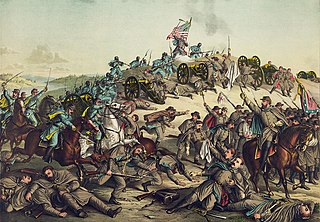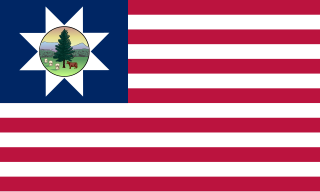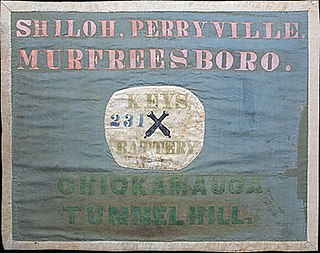
The Battle of Nashville was a two-day battle in the Franklin-Nashville Campaign that represented the end of large-scale fighting west of the coastal states in the American Civil War. It was fought at Nashville, Tennessee, on December 15–16, 1864, between the Confederate Army of Tennessee under Lieutenant General John Bell Hood and the Union Army of the Cumberland under Major General George H. Thomas. In one of the largest victories achieved by the Union Army during the war, Thomas attacked and routed Hood's army, largely destroying it as an effective fighting force.

The Battle of Peachtree Creek was fought in Georgia on July 20, 1864, as part of the Atlanta Campaign in the American Civil War. It was the first major attack by Lt. Gen. John Bell Hood since taking command of the Confederate Army of Tennessee. The attack was against Maj. Gen. William T. Sherman's Union army, which was perched on the doorstep of Atlanta. The main armies in the conflict were the Union Army of the Cumberland, commanded by Maj. Gen. George Henry Thomas and two corps of the Confederate Army of Tennessee.

The Battle of Adairsville was a battle of the Atlanta Campaign fought during the American Civil War on May 17, 1864, just northeast of Rome, Georgia. The brief engagement was a Confederate delaying action that allowed General Joseph E. Johnston to bait a trap for the Union army at Cassville.
The Second Battle of Dalton was fought August 14–15, 1864, between Union and Confederate forces in Whitfield County northern Georgia.

The Battle of Buck Head Creek was the second battle of Sherman's March to the Sea, fought November 28, 1864, during the American Civil War. Union Army cavalry under Brig. Gen. Hugh Judson Kilpatrick repulsed an attack by the small Confederate cavalry corps under Maj. Gen. Joseph Wheeler, but abandoned its attempt to destroy railroads and rescue Union prisoners of war.

The 3rd Vermont Infantry Regiment was a three-years infantry regiment in the Union Army during the American Civil War. It served in the eastern theater, predominantly in the VI Corps, Army of the Potomac, from July 1861 to July 1865. It was a member of the Vermont Brigade.

The 2nd Vermont Infantry Regiment was a three years' infantry regiment in the Union Army during the American Civil War. It served in the eastern theater, predominantly in the VI Corps, Army of the Potomac, from June 1861 to July 1865. It was a member of the famous Vermont Brigade.

The 4th Vermont Infantry Regiment was a three year' infantry regiment in the Union Army during the American Civil War. It served in the Eastern Theater, predominantly in the VI Corps, Army of the Potomac, from September 1861 to July 1865. It was a member of the Vermont Brigade.

The 5th Vermont Infantry Regiment was a three years' infantry regiment in the Union Army during the American Civil War.

The 6th Vermont Infantry Regiment was a three years' infantry regiment in the Union Army during the American Civil War. It served in the Eastern Theater, predominantly in the VI Corps, Army of the Potomac, from October 1861 to June 1865. It was a part of the Vermont Brigade.

The 17th Maine was organized at Camp King, Cape Elizabeth, and mustered on August 18, 1862. Left State for Washington, D. C., August 21. Attached to Defences of Washington to October, 1862. 3rd Brigade, 1st Division, 3rd Army Corps, Army Potomac, to March, 1864. 2nd Brigade, 3rd Division, 2nd Army Corps, to June, 1864. 1st Brigade, 3rd Division, 2nd Corps, to March, 1865. 2nd Brigade, 3rd Division, 2nd Corps, to June, 1865.

The 1st Michigan Sharpshooters Regiment was an infantry regiment that served in the Union Army's Army of the Potomac during the American Civil War.
1st Arkansas Mounted Rifles (1861–1865) was a Confederate States Army cavalry regiment during the American Civil War. The unit was formed as a mounted infantry regiment, but was dismounted in the spring of 1862 and remained dismounted for the remainder of the war. The unit participated in the earliest battles in the western theater at Wilson's Creek and surrendered with the remnants of the Army of Tennessee in North Carolina in April 1865.
The 10th Kentucky Infantry Regiment was an infantry regiment that served in the Union Army during the American Civil War.
The 83rd Indiana Infantry Regiment, sometimes called 83rd Indiana Volunteer Infantry Regiment, was an infantry regiment that served in the Union Army during the American Civil War.
The 2nd Arkansas Infantry was an army regiment of the Confederate Army during the American Civil War. The regiment was raised in May 1861 under Colonel Thomas C. Hindman. It served throughout the war in the western theater, in the Confederate Army of Tennessee, seeing action in the Kentucky, Tennessee and Georgia campaigns. Following its depletion in numbers, the regiment was consolidated several times with other Arkansas regiments, finally merging in 1865 into the 1st Arkansas Consolidated Infantry Regiment. The regiment has no connection with the 2nd Regiment, Arkansas State Troops, which participated in the Battle of Wilson's Creek, and is also separate from the 2nd Arkansas Consolidated Infantry Regiment, which was formed in 1864 from remnants of regiments surrendered at Vicksburg and Port Hudson.

The Manassas campaign was a series of military engagements in the Eastern Theater of the American Civil War.

The Helena Artillery (1861–1865) was a Confederate Army artillery battery during the American Civil War. The unit was known by several other designations during the war including; Clarkson's Battery, Company A, Shoup's Artillery Battalion, Calvert's Battery and Key's Battery. The unit was occasionally assigned to artillery battalions from other states, so the Arkansas unit was at various times designated as Company C, 20th Alabama Light Artillery Battalion and later as Company H, 28th Georgia Artillery Battalion.
The Battle of Camp Davies was a skirmish during the American Civil War on November 22, 1863, near a Union Army camp about six miles south of Corinth, Mississippi. A 70-man detachment of the 1st Regiment Alabama Cavalry (Union), commanded by Major Francis L. Cramer, drove off a 150-man Confederate force of the 16th Battalion, Mississippi Cavalry State Troops, commanded by Major Thomas W. Ham, and killed at least 4 Confederate soldiers, while suffering two severely wounded troopers. This action is the only engagement recorded as occurring at or near Camp Davies in major sources on American Civil War battles. Other similar engagements in the vicinity of Corinth in 1863 may have occurred near Camp Davies.
Harris's Missouri Battery was an artillery battery that served in the Confederate States Army during the American Civil War. The battery was organized in early 1864 when the 13th Missouri Light Battery was reorganized in a process that may not have been officially approved; Captain Samuel Stanhope Harris commanded the new unit. The battery fought in the Camden Expedition in early 1864, seeing action in the Battle of Prairie D'Ane and the Battle of Poison Spring in April. In June, the battery was present at the Battle of Ditch Bayou. Harris's Battery accompanied Sterling Price during his raid into Missouri in late 1864, during which it fought at the battles of Pilot Knob, Glasgow, Little Blue River, Big Blue River, and Mine Creek, as well as several smaller skirmishes. At Mine Creek, the battery's cannons were captured. On May 26, 1865, the battery surrendered; the men of the battery were paroled.












